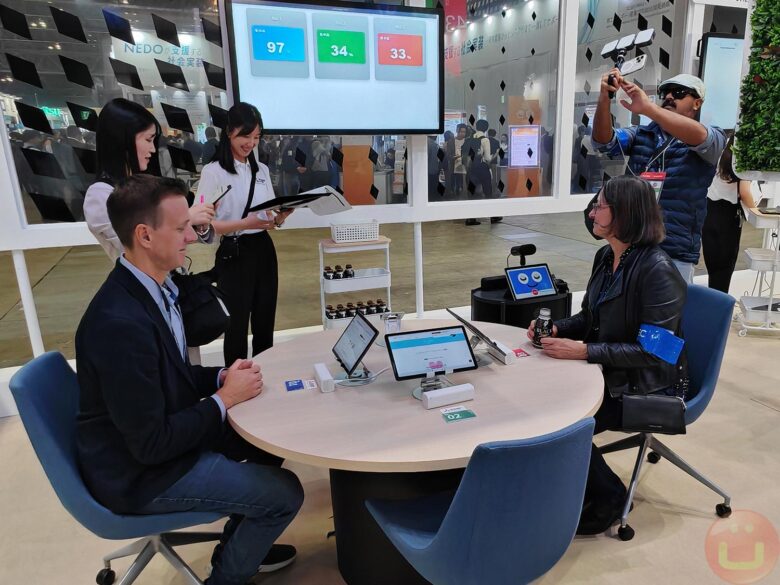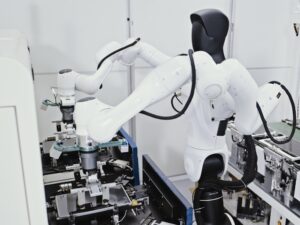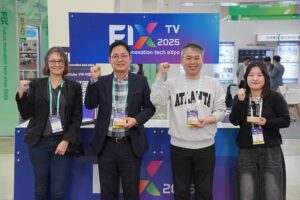At CEATEC 2025, Mitsubishi Electric showcased a vision of the workplace where technology and emotion coexist in harmony. The company’s Emoco Analytics Service connects contactless vital sensing with artificial intelligence to create a comfortable office that responds to people’s physical and emotional states in real time. During the show, I participated in the live demonstration—sitting in front of the Emoco Eye contactless sensor as it monitored my concentration and mood without any physical contact.

Rich DeMuro and Eliane Fiolet participating in Mitsubishi Electric’s Emoco Analytics Service demo at CEATEC 2025. Each monitor is paired with an Emoco Eye sensor that measures pulse and concentration without contact, the AI is displaying the real-time concentration level of each participant on the shared screen.
Emoco Analytics Service Demo at CEATEC 2025
At CEATEC 2025, Mitsubishi Electric recreated a compact office environment to show how the Emoco Analytics Service could make workspaces truly adaptive. The setup featured a round table equipped with monitors, each paired with a small white device housing the Emoco Eye sensor just below the screen.
I participated in the experiment with fellow U.S. journalist Rich DeMuro (follow him on Rich on Tech and his YT channel). The session began with a one-minute measurement as the sensor captured our pulse and blood-flow variations. The Emoco Eye vital sensor measures the frequency and waveform of a person’s pulse without contact, using quasi-millimeter-wave Doppler technology to detect the tiny movements of blood flow linked to each heartbeat. The data were then sent to the cloud, where Mitsubishi’s Serendie platform analyzed our physiological state in real time.
A large display behind us showed the results immediately. My concentration score was 33%, while Rich’s was 97%, clearly illustrating contrasting focus levels. Another indicator represented sleepiness, allowing the audience to compare mental engagement and fatigue. According to Mitsubishi Electric’s staff, the AI continuously recalculated these values to determine how best to adjust each participant’s surroundings.
As the demo progressed, the environment came alive. The Misola blue-sky lighting panels above us shifted color temperature to restore alertness, while the air-conditioning vents adjusted airflow to maintain comfort. When the AI determined that a participant appeared to need a short break, a mobile robot assistant with friendly digital “eyes” approached to make the suggestion—offering a cup of coffee as a gentle prompt to relax.

On the ceiling, triggered in real time by the Emocotech system, the Misola blue-sky lighting panels shifted color temperature to restore alertness, while the air-conditioning vents adjusted airflow to maintain comfort.
The demonstration was remarkably discreet: no cameras, no wearables, no manual interaction. The Emoco Eye quietly gathered biometric data, and the AI translated those signals into actions, orchestrating comfort through lighting, temperature, and robotics. Mitsubishi Electric’s engineers emphasized that the goal was not surveillance but comfort—to create environments that sense how people feel and adapt automatically to improve focus, well-being, and productivity.

The mobile robot assistant is offering me a cup of cold coffee
Mitsubishi R&D: From Smart Air Conditioning to Emotion-Aware Comfort
Mitsubishi Electric’s focus on human comfort began more than a decade ago with the 3D i-See Sensor, a thermal-imaging system built into its high-end Kirigamine and Mr. Slim air conditioners. By mapping heat distribution and detecting where people were sitting, it automatically adjusted airflow and temperature. It was one of the first examples of an air conditioner that could “see” its users and react accordingly—the foundation for what would later become emotion-responsive control (Mitsubishi Electric introducing 3D sensor, 2016).
Starting around 2019, Mitsubishi’s research teams began exploring electromagnetic (EM) wave sensing to move beyond thermal detection and measure vital signs such as pulse and respiration without contact. By 2021, engineers at the company’s Information Technology R&D Center in Kanagawa had developed 24 GHz quasi-millimeter-wave Doppler sensing, capable of detecting the tiny expansion of blood vessels with each heartbeat (Mitsubishi Electric 2021).

The Emoco Eye sensor is housed inside the white device on the right. For demonstration purposes, Mitsubishi Electric displayed the uncovered sensor module on the left.
That work led to the Emoco Eye, a small module that emits low-power radio waves and reads the reflections to measure pulse patterns. The data are interpreted by AI models trained to link subtle changes in pulse rhythm with a person’s physical or emotional condition—such as focus, fatigue, or relaxation. Mitsubishi calls this concept “Emocotech,” short for emotion-responsive technology, which uses sensors and AI to make indoor environments more comfortable on both physical and psychological levels.
The Emoco Eye contactless vital sensor is part of a larger connected system. It sends data to Mitsubishi’s Serendie platform, where AI analyzes the information and coordinates responses across lighting, air conditioning, and other devices. Within the sensor, AI also helps filter and classify Doppler signals, turning faint physiological data into actionable insights. The result is a continuous feedback loop in which sensing, analysis, and environmental adjustment occur seamlessly.

This research fits within Mitsubishi Electric’s broader Kaiteki philosophy—the pursuit of comfort and well-being through technology. Featured on the company’s “Kaiteki Labo” website, the Emoco Eye project explores how subtle biological cues can guide machines to support human comfort. From detecting heat to understanding emotional state, Mitsubishi Electric’s progress shows a consistent goal: using technology not just to control the air, but to create spaces that make people feel at ease.
Envisioning a Human-Centric Future
While still experimental, the Emoco Analytics Service illustrates Mitsubishi Electric’s long-term vision for emotion-adaptive environments. The company foresees its Emocotech AI expanding beyond offices into homes, healthcare, mobility, and contextual customer service—anywhere comfort and emotional balance matter.
In these scenarios, AI acts as the orchestrator that turns ambient devices into responsive companions. Air conditioners could calm stress rather than simply cool air; lighting could energize or relax users automatically; cars might adjust cabin conditions to a driver’s alertness; and public spaces could adapt to collective mood.
Mitsubishi Electric’s CEATEC showcase suggests that the next generation of smart environments will not only understand where we are but also how we feel—creating spaces that are perceptive, adaptive, and centered on human comfort.
This reflected the Society 5.0 theme highlighted in Mitsubishi Electric’s official press materials—a concept that describes a human-centered society balancing technological advancement and well-being. Society 5.0 was also a concept underlining the IPA (Information-technology Promotion Agency, Japan) hybrid theatrical-VR installation showcased at CEATEC 2025.
Mitsubishi’s “Emoco” Sensor and AI Makes Offices More Comfortable by Reading Human Emotions
, original content from Ubergizmo. Read our Copyrights and terms of use.



